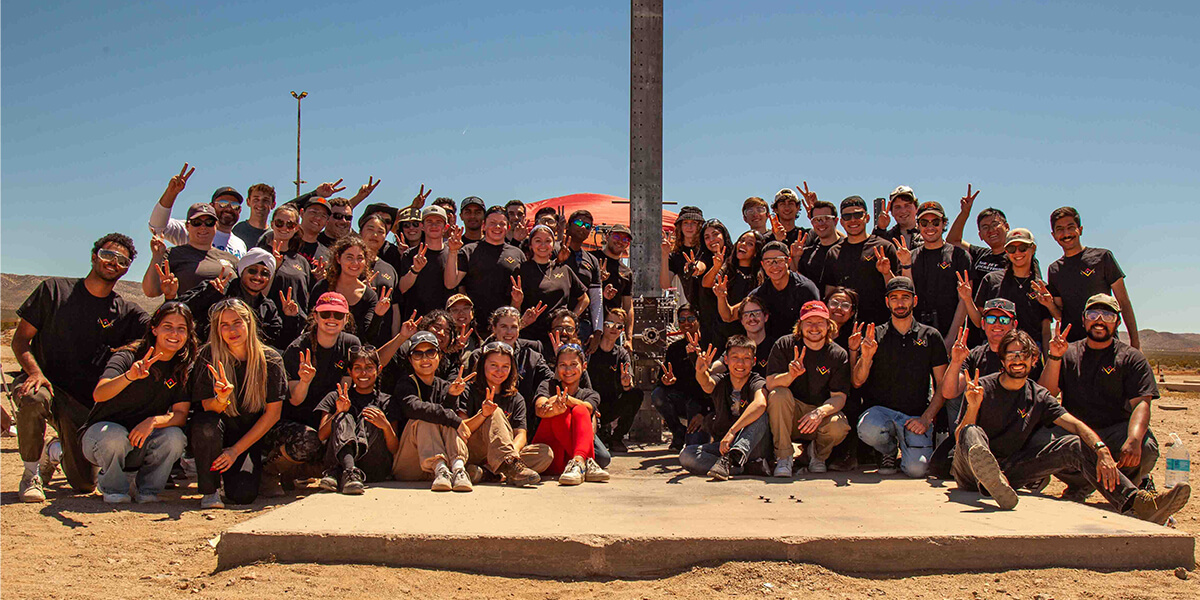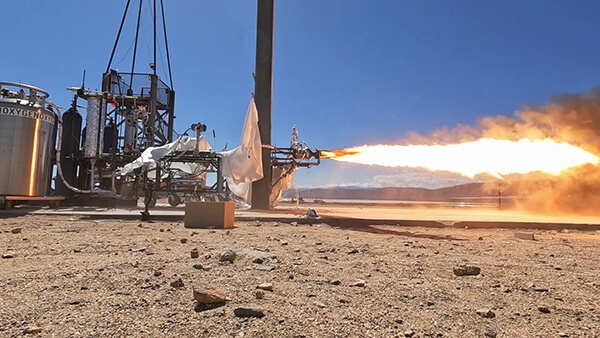
The 2024 LPL team during a test fire in the Mojave Desert
The advancement of liquid-fueled rocket technology is a top priority for the space industry, and the student-run Liquid Propulsion Lab (LPL) at the USC Department of Astronautical Engineering is an incubator for training the engineers who will be – and have been – central to this mission. Through the conceptualization, design, manufacturing and testing of industry-grade liquid rocket engines and feed systems, graduate students (and a few stellar undergraduates) have the chance to convert engineering theory into practical experience.
Crucially, liquid propulsion systems are optimized for reuse after firing; no small consideration, given the time-based, economic, and material resources involved in designing, building and launching a rocket. The sustainability of the space industry relies on rocket engine reuse, and LPL keeps pace with the R&D teams at top space companies and Southern California’s thriving aerospace startup culture.
The past year has been a standout series of milestones for LPL, and we caught up with lead engineers Rohin Pathak and Sebastian Bouckenooghe to hear more about the team’s recent successes and future plans.
What do you consider LPL’s most groundbreaking achievement over the past year?
RP & SB: December 2023 marked a watershed moment when we achieved the second successful hot fire of Mike’s Fury, a 3D-printed Kerosene and Liquid Oxygen regeneratively cooled engine. This engine, characterized by its affordability, ease of manufacturing and operational efficiency, represents a significant leap forward in liquid propulsion technology – it’s worth noting that very few student teams have accomplished multiple successful firings of a reusable engine.
The hot fire was all the more noteworthy, given the rapid resolution of technical challenges through the seamless integration of thrust vectoring maneuvers as part of the Thrust Vector Challenge. This rigorous test demands a propulsion system capable of executing a Thrust Vector Control (TVC) maneuver with precision and versatility. During the hot fire phase, the system is engineered to execute a TVC encompassing a 7-degree deflection in all directions, essentially tracing a circular path that adds a layer of complexity to the assessment.
The successful execution of this test underscored the effectiveness of LPL’s propulsion systems and testing infrastructure. Furthermore, the data collected provided valuable feedback for further optimization of LPL’s engines.

Hot fire of the Balerion engine in summer 2024
You recently took your Balerion and Jessie & James engines to the Mojave Desert for testing – what makes these engines so special?
Balerion is one of the nation’s most powerful student-made liquid rocket engines, and it marks our transition from 3D-printed kerosene/gaseous oxygen engines to regeneratively cooled cryogenic systems. The engine was also an experiment in integrating a new advanced material, Inconel-718.
The J&J engine showcases a newly designed pintle injector system, which optimizes fuel injection for improved combustion efficiency. Additionally, both engines incorporate a revolutionary manufacturing process known as additive manufacturing. This technique allows for the creation of complex engine components by 3D printing, thereby reducing manufacturing time and costs while enhancing performance.
What are the team’s goals for the coming year? In what ways do these align with wider industry priorities?
Looking ahead, LPL has ambitious goals for 2024 that align with wider industry priorities. These include testing the newly redesigned and manufactured injector system for the J&J engine, as well as conducting hot fires for both Balerion Dev-2 and J&J engines. Additionally, LPL aims to test a throttleable propulsion system, showcasing its commitment to innovation and advancement in liquid rocket technology.
What is the secret of LPL’s successful team dynamic, and what do you enjoy most about your joint role as lead engineers?
The “secret” of LPL’s successful team dynamic is our dedication and commitment. As rudimentary as that sounds, we believe it to be the driving force in our lab. We could not have met our goals this semester if it weren’t for our members’ ability to work so diligently for hours on end. We believe that we have the most motivated and capable students in our lab to achieve these incredible goals and each year we prove we can go further and work harder.
Published on June 12th, 2024
Last updated on June 15th, 2024







